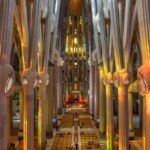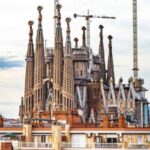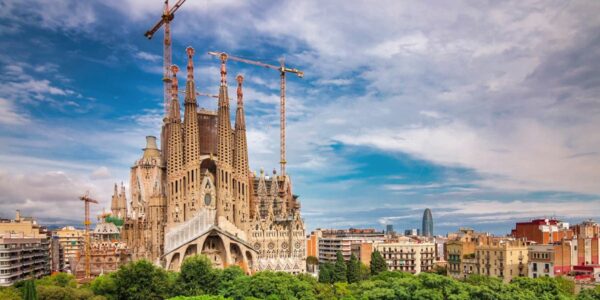
- The Architectural Marvel of Sagrada Familia: A Closer Look at Gaudí's Vision
- Exploring the Symbolism Behind Sagrada Familia's Iconic Towers
- The Stunning Facades of Sagrada Familia: Artistry and Meaning
- Visiting Sagrada Familia: Tips for Experiencing Barcelona's Masterpiece
- The Spiritual Significance of Sagrada Familia's Design Elements
- A Guide to Understanding the History and Future of Sagrada Familia
The Sagrada Familia, a masterpiece designed by the renowned architect Antoni Gaudí, stands as a testament to the extraordinary fusion of architecture and nature. Its towering spires and intricate facades draw millions of visitors each year, making it a symbol of Barcelona’s rich cultural heritage.
In exploring The Majestic Beauty of Sagrada Familia: Barcelona's Iconic Towers, one can appreciate not only the artistic genius of Gaudí but also the spiritual message embedded within its design. Each tower represents a significant aspect of Christianity, inviting admiration and reflection from all who gaze upon this architectural wonder.
The Architectural Marvel of Sagrada Familia: A Closer Look at Gaudí's Vision
The Sagrada Familia is not just a church; it is a profound architectural marvel that intertwines nature, religion, and art. Gaudí's innovative use of hyperboloids and parabolas creates a structure that mimics the forms found in nature, standing as a tribute to God's creation. The design incorporates a unique combination of Gothic and Art Nouveau styles, resulting in a breathtaking aesthetic that captivates all who visit.
At the heart of Gaudí's vision is the concept of light. The Sagrada Familia features intricate stained-glass windows that cast a kaleidoscope of colors within its interior, symbolizing divine illumination. This interplay of light not only enhances the spiritual atmosphere but also highlights the details of Gaudí's craftsmanship, such as:
- Organic shapes that reflect natural elements
- Intricate sculptures that narrate biblical stories
- Sculptural forms that appear to grow from the ground
Gaudí's attention to detail extends to the towers, each representing different saints. The tallest tower, dedicated to Jesus, will soar to an impressive height of 172.5 meters, making it the tallest religious building in Europe once completed. This design decision is not simply for aesthetic purposes; it embodies Gaudí's belief that spiritual elevation should be reflected in the height of the structure. The towers are adorned with rich symbolism, inviting deeper understanding and connection with the divine.
Moreover, the structure’s completion has been a continuous journey, reflecting the evolving nature of both art and architecture. As construction progresses, modern techniques blend with traditional craftsmanship, ensuring that Gaudí's original vision remains intact while embracing contemporary advancements. This dynamic relationship between the past and present makes the Sagrada Familia a unique testament to the enduring power of faith and creativity.
Exploring the Symbolism Behind Sagrada Familia's Iconic Towers
The iconic towers of the Sagrada Familia are not merely architectural elements; they are imbued with deep symbolism that resonates with the Christian faith. Each tower tells a story, reflecting the life of a saint or a biblical figure, and serves as a reminder of their virtues. This thoughtful representation encourages visitors to engage with the spiritual significance of the monument, enriching their experience as they explore the site.
Gaudí designed the towers to represent the Apostles, the Virgin Mary, and Jesus Christ, each expressed through unique forms and heights. The towers can be categorized as follows:
- Jesus Tower: The tallest, symbolizing the central figure of Christianity.
- Mary Tower: A representation of grace and purity.
- Apostles Towers: Each dedicated to one of Christ's followers, emphasizing their foundational role in spreading the faith.
Additionally, the towers are adorned with intricate details that echo Gaudí's philosophy of nature. Utilizing natural motifs and organic shapes, these elements not only enhance the visual appeal but also reinforce the connection between the divine and the natural world. The overall design serves as a metaphor for the ascent towards the heavens, guiding the faithful in their spiritual journey.
As construction continues, the evolving design of the Sagrada Familia remains faithful to Gaudí’s visionary philosophy while incorporating modern advancements. This ongoing project symbolizes a bridge between past and present, inviting reflection on how architecture can express profound spiritual truths while adapting to the needs of contemporary society.
The Stunning Facades of Sagrada Familia: Artistry and Meaning
The facades of the Sagrada Familia serve as a breathtaking canvas of Gaudí's artistic vision, revealing layers of meaning and craftsmanship. Each facade—Nativity, Passion, and Glory—encapsulates essential themes of the Christian faith, inviting contemplation and admiration. The intricate sculptures and designs reflect not only religious narratives but also the harmony between architecture and nature.
In detail, the Nativity Facade celebrates the birth of Christ through vibrant imagery and organic forms, showcasing Gaudí's devotion to nature. This facade includes:
- Symbolic sculptures: Representing various biblical characters and scenes.
- Nature-inspired elements: Such as trees and animals, highlighting God's creations.
- Stained-glass windows: Casting colorful light that enhances the spiritual atmosphere.
Conversely, the Passion Facade conveys the suffering and sacrifice of Christ through stark, angular designs that evoke a sense of urgency and reflection. The dramatic contrasts in this facade serve to remind visitors of the depth of Christ's sacrifice, emphasizing:
- Emotionally charged sculptures: Portraying the crucifixion and the last moments of Jesus.
- Minimalist details: Reflecting the somber tone of the narrative.
- Light and shadow play: Evoking a somber yet poignant atmosphere.
Lastly, the Glory Facade represents the resurrection and the heavenly glory of Christ, symbolizing hope and redemption. This facade is designed to inspire awe, signifying the ultimate triumph of faith. Through Gaudí's mastery, these facades collectively narrate a profound story of spirituality, artistry, and the intricate relationship between humanity and the divine.
Visiting Sagrada Familia: Tips for Experiencing Barcelona's Masterpiece
When planning your visit to the Sagrada Familia, it’s essential to book your tickets in advance. Skip-the-line options allow you to avoid long waits, giving you more time to explore this stunning masterpiece. Additionally, consider visiting during off-peak hours, such as early mornings or late afternoons, to enjoy a more tranquil experience as you admire Gaudí’s intricate designs and towering spires.
To fully appreciate the architectural brilliance of this iconic structure, take a guided tour. A knowledgeable guide can provide valuable insights into Gaudí's vision and the meanings behind various elements of the basilica. Alternatively, audio guides are available, offering flexibility for those who prefer to explore at their own pace while still gaining an understanding of the church’s rich history and symbolism.
Don’t forget to take your time absorbing the stunning details of both the exterior and interior. The play of light and color through the stained-glass windows is a breathtaking experience that enhances the spiritual atmosphere of the space. Make sure to bring your camera; capturing the exquisite details of the facades and towers will allow you to remember the beauty of the Sagrada Familia long after your visit.
Finally, consider combining your visit with a stroll through the surrounding park areas. The grassy spaces around the Sagrada Familia offer a perfect backdrop for photographs, as well as a peaceful environment to reflect on the artistry you’ve just witnessed. Exploring the nearby streets will also lead you to charming cafes and shops where you can enjoy local cuisine and souvenirs that celebrate Barcelona's rich cultural heritage.
The Spiritual Significance of Sagrada Familia's Design Elements
The Sagrada Familia is a profound embodiment of spiritual significance, intricately woven into its design elements. Gaudí's vision was to create a space that transcends mere architecture, aiming instead to reflect divine principles. Each aspect of the basilica is a manifestation of faith, from the soaring towers that reach toward the heavens to the rich symbolism found throughout its facades, inviting both worship and admiration.
One of the most striking design elements is the use of light. Gaudí believed that light represents divinity, illuminating the sacred space and enhancing the spiritual experience of visitors. The stained-glass windows are thoughtfully designed to filter sunlight, creating a dynamic play of color within the interior that symbolizes the presence of the Holy Spirit. This interplay emphasizes the connection between the earthly and the heavenly, embodying the essence of spiritual awakening.
Moreover, the organic shapes and natural motifs throughout Sagrada Familia reflect Gaudí's belief that nature is a direct expression of God's creativity. Elements such as tree-like columns and floral designs serve not only as structural supports but also as reminders of the divine presence in nature. This philosophy encourages visitors to contemplate their place within the larger tapestry of creation, reinforcing the idea that spirituality is intricately linked to the natural world.
Finally, the incorporation of religious iconography into the architectural details deepens the spiritual significance of the Sagrada Familia. Each sculpture and carving serves a dual purpose: to enhance the aesthetic beauty of the structure while conveying biblical narratives and virtues. This harmonious blend of art and faith transforms the basilica into a living testament to the power of spirituality, inviting all who enter to reflect on their own spiritual journeys.
A Guide to Understanding the History and Future of Sagrada Familia
The history of the Sagrada Familia is as intricate as its design, with construction beginning in 1882 under the guidance of Francisco de Paula del Villar. However, it was Antoni Gaudí who took over the project a year later, transforming it into a unique expression of his artistic vision. Over the decades, this basilica has evolved, incorporating various architectural styles while remaining true to Gaudí's ethos. The ongoing construction, fueled by public and private donations, reflects not only the challenges of realizing Gaudí's complex designs but also the enduring passion for this iconic structure.
Looking towards the future, the Sagrada Familia is projected to be completed by 2026, coinciding with the centenary of Gaudí's death. This timeline has spurred advancements in construction techniques that blend modern technology with traditional craftsmanship. As the project nears completion, the integration of new materials aims to preserve Gaudí's original vision while enhancing the structural integrity of this architectural marvel. The commitment to sustainability is also paramount, as builders strive to minimize environmental impact.
Visitors can engage with the history and future of the Sagrada Familia through various educational programs and exhibitions. These initiatives provide insights into the construction process and the significance of Gaudí's work. Key aspects of this journey include:
- Interactive displays: Showcasing the evolution of the design and engineering challenges.
- Workshops: Allowing participants to explore architectural concepts inspired by Gaudí.
- Guided tours: Offering detailed explanations of the symbolism and artistry behind the towers and facades.
In understanding the Sagrada Familia, one realizes that it is more than just a building; it represents a testament to human creativity and faith. As it continues to rise against the Barcelona skyline, this masterpiece stands as a beacon of hope and a reminder of the intersection between art, spirituality, and the relentless pursuit of perfection.
 Get Your Tickets to Sagrada Familia Barcelona: A Must-See Landmark
Get Your Tickets to Sagrada Familia Barcelona: A Must-See Landmark From Sagrada Familia to Barcelona Airport: Your Ultimate Guide to Seamless Transfers
From Sagrada Familia to Barcelona Airport: Your Ultimate Guide to Seamless Transfers Exploring the Majestic Sagrada Familia: A Fascinating Barcelona Walking Tour
Exploring the Majestic Sagrada Familia: A Fascinating Barcelona Walking Tour Unveiling the Majestic Towers of the Sagrada Familia in Barcelona
Unveiling the Majestic Towers of the Sagrada Familia in BarcelonaIf you want to know other articles similar to The Majestic Beauty of Sagrada Familia: Barcelona's Iconic Towers you can visit the category WHERE YOU CAN GO.
Deja una respuesta










Read more!